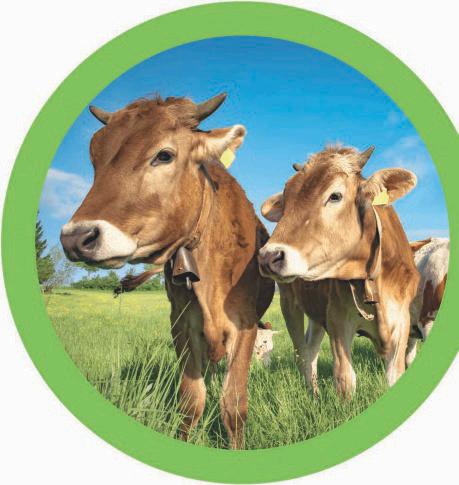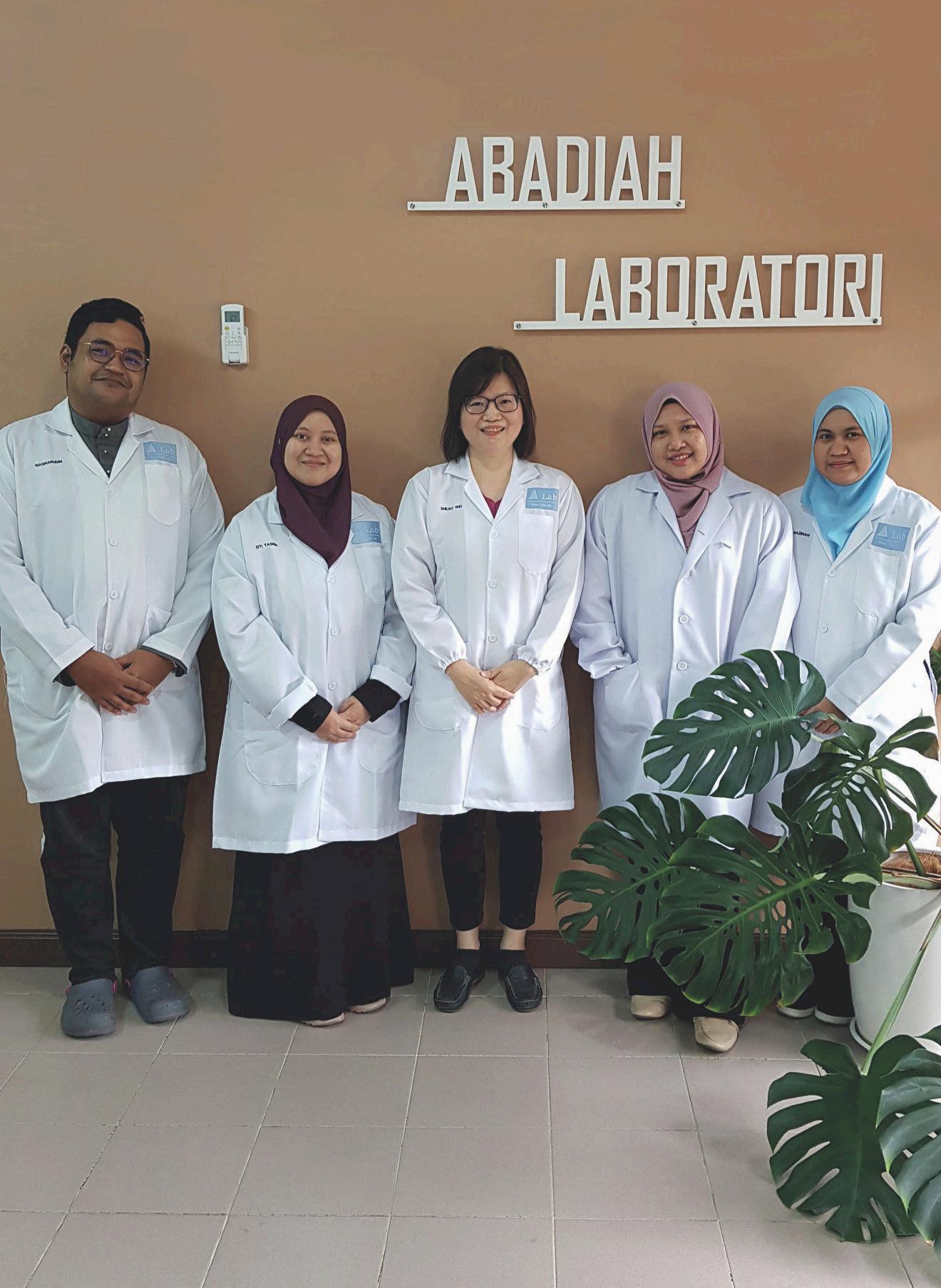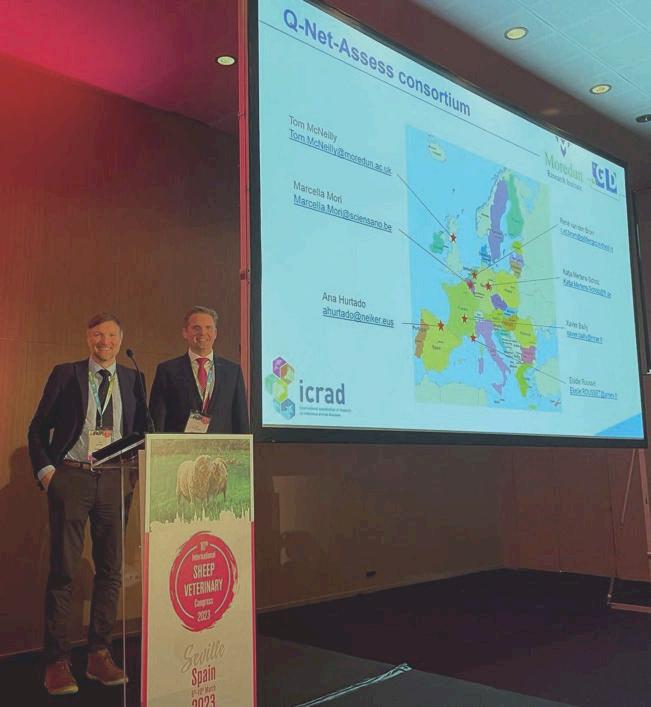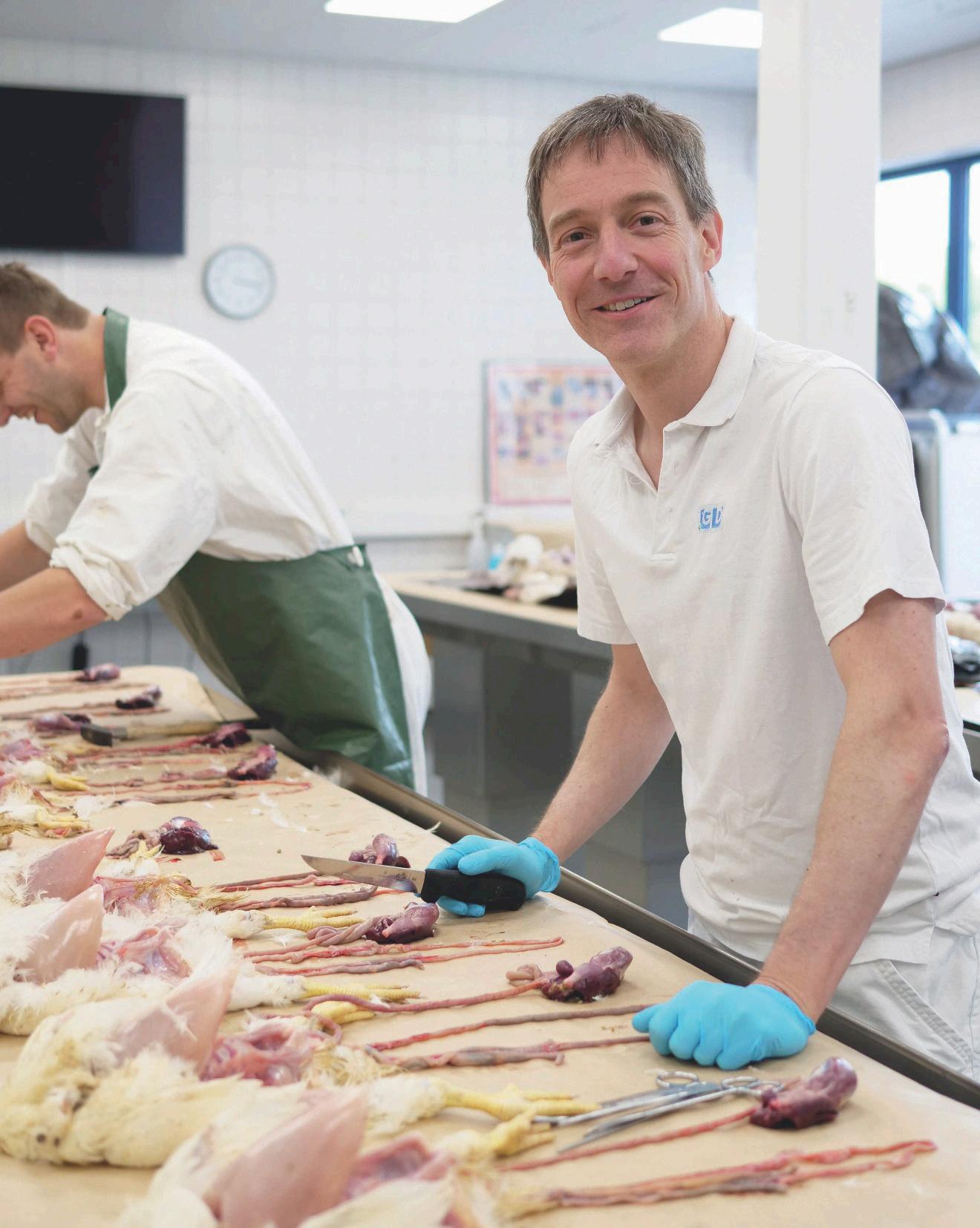SOUND CONTROL
Need for output-based surveillance




COLLABORATION
Meeting the needs and expectations of local customers together
CONSORTIUM
Mapping instigators of Q fever

SOUND CONTROL
Need for output-based surveillance




COLLABORATION
Meeting the needs and expectations of local customers together
CONSORTIUM
Mapping instigators of Q fever
Why participate?
There are many good reasons to participate in pro ciency testing schemes:
1. Evaluating the performance of the laboratory
2. Maintaining/achieving accreditation to ISO 17025


3. Providing additional con dence
4. Identifying interlaboratory differences
5. Identifying problems
Application and questions
More information about our PTS and the application form can be found on our website www.gdanimalhealth.com/PTS.
Cat. no. Pro ciency testing scheme
Round 6
VLDIA323 PTS Bacterial Identi cation cattle
VLDIA324 PTS Antibiotic susceptibility of bacterial strains cattle
VLDIA323 PTS Bacterial Identi cation swine
VLDIA324 PTS Antibiotic susceptibility of bacterial strains swine
Round 7
VLDIA255 PTS aMPV antibody detection (TRT)
VLDIA277 PTS ARV antibody detection (REO)
VLDIA292 PTS ILT antibody detection
VLDIA329 PTS CAV antibody detection
VLDIA333 PTS IBR antibody detection (serum)
August 11 Week 35 October 6 Week 48
August 18 Week 36 October 27 Week 51
If you have any questions, please do not hesitate to contact us via pts@gdanimalhealth.com.
VLDIA334 PTS IBR antibody detection (milk)
VLDIA335 PTS IBR antibody detection (milk and serum)
Round 8
VLDIA232 PTS AI antibody detection
VLDIA327 PTS AI virus detection
VLDIA233 PTS Salmonella poultry antibody detection
VLDIA171 PTS Salmonella porcine antibody detection
VLDIA295 PTS SIV antibody detection
September 8 Week 39 November 17 Week 2 2024
View the entire schedule: www.gdanimalhealth.com/pts/timeschedule
Pathogens don’t care about borders. This has become ever more apparent in the worldwide outbreak of avian in uenza in the past months. Viruses and bacteria spread either through wildlife or international transport of live animals or food products. Hence the importance of the animal health surveillance program in The Netherlands, which celebrates its 20th anniversary this year (page 5).
However, as the spread of diseases won’t stop at the border, neither do we. GD is part of a large number of international consortia studying animal health and disease, like the Cost action SOUND control (page 4). Recently, we stood at the basis of a pan-european consortium on studying Q-fever and the pathogens causing this disease. Read more about how this con
sortium came to be and what it aims to achieve on page 8 and 9. And by working with local distributors we try to bring our expertise, products and services even beyond Europe. Our newest distributor in Asia is introduced on page 6 and 7. So regardless of where you are located, GD would like to be your partner. Either through providing our products or services to you or through collaborating on one of our innovative projects.
To get a sneak preview of what kind of innovative projects we work on, fast forward to page 10 to read about our Ethometer. This project is an excellent example of how we combine our years of expertise in monitoring and managing animal disease with the latest technological developments in the eld. All together this edition of Update should give you an idea of GD’s cross-border research and innovation, all focused on decreasing the burden of animal disease, worldwide.
Berend Oosterhuis, Director of Contract Research & Consulting



CONTACT INFORMATION ROYAL GD
If you want to know more about what GD can do for you, please contact one of our staff members, responsible for international sales:
Wim Kieftenbeld Head Business Development w.kieftenbeld@ gdanimalhealth.com

Annemiek Kolkman
Area sales manager a.kolkman@ gdanimalhealth.com

Jarno Smit
Area sales manager GD Academy j.smit@gdanimalhealth.com
Mattheus Hekman
Area sales manager m.hekman@ gdanimalhealth.com
Sebastiaan Bierma Area sales manager s.bierma@ gdanimalhealth.com


Anna Romanova
Area sales manager a.romanova@ gdanimalhealth.com
Tetiana Kopniak
Area sales manager t.kopniak@ gdanimalhealth.com
Berend Oosterhuis Director of Contract Research & Consulting b.oosterhuis@gddiergezondheid.nl

Eveline Peereboom Business manager e.peereboom@ gdanimalhealth.com

Fanny Nieuwenhuis Senior account manager f.nieuwenhuis@ gdanimalhealth.com







Ellen Koetsier Sales support support@gdanimalhealth. com
in ‘t Veld Sales support support@gdanimalhealth.com



Janine Boertien Sales support support@gdanimalhealth. com
Nanda Pastoor Coordinator GD Academy GDAcademy@ gdanimalhealth.com
25, 7418 EW Deventer, the Netherlands
04 SOUND control: need for output-based surveillance
05 Twenty years of monitoring in the Netherlands. Heading for a healthy future together
06 Meeting the needs and expectations of local customers together
08 Consortium gets to work ok mapping instigators of Q fever
10 Ethometer: monitoring animal behaviour
11 News & communications
12 GD Specialist: Robert Jan Molenaar

In the new animal health law that entered into force in 2021, infectious cattle diseases are categorized based on their impact from A (highest impact) to E. For diseases categorized under A or B, regulations on control and eradication are prescribed. For diseases categorized under C, D or E, rules are not so strict. Examples of these diseases include BVDV, BoHV1 and Paratuberculosis.
For these diseases many European countries/regions have their own speci c disease control programme in place. Nevertheless, these differently designed programmes result in differences of prevalence of disease and therefore in a risk of (re)infection when cattle are traded between countries or regions with a different disease status. To be able to reduce the risk of such trade there is a need for the possibility to compare the status of traded cattle (the probability of being free) originating from
different control programmes. This is called output based comparison or in other words, comparison of the results of different programmes. Until now, the methods that can be applied for output-based surveillance are very limited.
The project
Between 2018 and 2022, the COST Action SOUND control was in place in which more than 100 researchers from 33 countries collaborated to stimulate uptake of output-based methods to substantiate the con dence of freedom for cattle diseases categorized under C, D or E in the EU.

Achievements
A thorough overview was created in which all cattle diseases that are controlled in at least one European country were described. The results were both published in a paper (Hodnik et al., 2021) and in a freely accessible digital dashboard. More detailed information about control of cattle diseases in the individual countries were published in a handbook lled with peer-reviewed scienti c publications. A joint effort of the SOUND-control members led to development of a digital and open-access data collection matrix, which was used to collect quantitative data in support of output-based surveillance. Existing methods for output-based surveillance were evaluated and disseminated through webinars and workshops. Additionally, gaps in output-based surveillance from the perspective of Action members, decision makers, industry stakeholders and farmers throughout Europe were collected and collated. All identi ed gaps with their implications and possible solutions served as basis for the research agenda for further development and implementation of output-based surveillance which was published at the end of the Action.
IF YOU ARE INTERESTED IN THIS PROJECT, SCAN THE QR-CODE
In the Netherlands, the collaboration between the government, corporate sector, human and animal healthcare is the key to success of the animal healthcare monitor. Twenty years down the road, this monitor is as important as ever for animal health and animal welfare, as well as protecting public health and the export position.
Where animals and people live together, an accurate system that constantly tracks the health of animals is absolutely essential. The monitor was established by Royal GD in collaboration with the government and the livestock farming sector back in 2002, as an addition to the monitoring programmes for specific animal diseases.
Signals are received from farmers in various sectors (cattle, swine, poultry, small ruminants and equine), veterinarians, the processing industry, research institutes and organisations responsible for public health. The monitor researches, bundles and analyses these signals derived from mutually complementing instruments. The results are shared with farmers, veterinari-
Cattle
•Bulk tank milk mastitis
•Bovine Viral Diarrhoea
•Paratuberculosis
• Bulk tank milk minerals, claw health, parasites
Poultry
•Antibiotic reduction
•Mortality reduction
• Mycoplasma gallisepticum
• Mycoplasma synoviae
•Salmonella
Swine
•PRRS
ans and relevant parties, such as the government, livestock sector, human healthcare providers and neighbouring countries (where relevant).
Good overview essential
Lotte Roos is the coordinator of the animal health monitor at GD. “Thanks to the monitor, we have an effective overview of the situation and can quickly initiate further investigation when prompted. This all contributes to taking correct and timely measures, both in practice and at the policy level. In order for this to work well, effective collaboration between all the parties is essential. Collaboration and a continuous search for possibilities for improvement, are the basis for the Dutch approach.”
With regard to research and exchange of knowledge GD works together with a broad international network of researchers and laboratories. Thanks to this exchange, monitoring information can be placed in a broader, international framework, thus improving the chances of early detection of new diseases and greater insight into the best possible response. Animal diseases do not stop at national borders and the threat of new diseases is always present, with developments such as climate change and travel movements of people and animals.
•Aujeszky’s disease
•Piglet OK
Small ruminants
• Maedi Visna/Caprine arthritis encephalitis
•Caseous lymphadenitis
• Bulk tank milk
Coxiella burnetii
We have developed animal health programmes for our international approach. These programmes have been made practically applicable for foreign markets, based on best practices in the Netherlands. There lies the greatest demand. The figure below shows an overview of our international programmes for the poultry, swine, cattle and small ruminants animal groups.





Together we are stronger. That’s why we reach out to others for their knowledge and to share ours and so establish an international distribution network. In this edition we would like to introduce a new member of our network: Abadiah Laboratori Sdn Bhd from Malaysia. Here we tell you more about this collaboration.
A new player in animal health, Abadiah Laboratori Sdn Bhd (Abadiah Lab) has been providing expertise and diagnostic testing to the poultry livestock industry since 2020. Why poultry? Because poultry farming is the largest livestock industry in Malaysia.
Although Abadiah Lab’s collaboration with GD only dates back to May 2022, the industry feedback has already been very positive. Local farmers, veterinarians, veterinary pharmaceutical companies, animal feed companies and local authorities are all looking forward to engaging with GD and its diagnostic products, laboratory assurance programme and training. Indeed, many stakeholders in the animal health industry in Malaysia had already experienced GD services such as its Proficiency Test Scheme (PTS) which offers important criteria for assessing laboratory performance and accreditation. It was against this positive background that Abadiah Lab did not hesitate to accept the opportunity to work with GD as a distributor of its products.
A local distributor for a global provider is essential, asserts Dr. Tan Sheau Wei at Abadiah Lab, “A distributor can easily identify and understand the needs and concerns of Malaysian stakeholders in combating infectious animal diseases and improving
production. Furthermore, the distributor has experience and knowledge of local practices and regulations, facilitating the development of relevant animal health programmes and the import of related products.”

As a provider of serological and PCR tests, as well as sequencing and bioinformatic analysis, Abadiah Lab will work with GD to meet the vaccine efficacy and training needs of the Malaysian poultry industry. Together the two companies will offer customers knowledge-based solutions safeguarding the performance and reliability of diagnostic tests and offer dedicated education and training in animal health. One such solution is the online Insight in Poultry Health and Food Safety training that Abadiah Lab and GD launched at the end of 2022. As far as Dr. Tan is concerned, everyone will benefit from the collaboration, “Abadiah Lab hopes that the online training will connect GD to the local market and local participants will benefit.” Aimed particularly at local poultry farmers and veterinary pharmaceutical companies, this training is just one example of how local knowledge and external expertise can come together to offer local stakeholders the skills they need.
By working together, GD and Abadiah Lab can ensure that expertise and technology are transferred efficiently and meet the needs and expectations of local customers. Dr. Tan, “Our clients are looking forward to the engagement with GD in diagnostic products, laboratory quality assurance and training.”
Institutes from six European countries join forces to gain extra information on the bacterium Coxiella burnetii. This bacterium is for the causal agent of Q fever, a zoonotic infection. The consortium is to start work in May of this year. Extensive research is planned for the coming years. The objective is to improve molecular surveillance and assess the host adaptation and virulence of C. burnetii in Europe.

Cattle, sheep and goats are the main reservoir and shedders of C. burnetii. People can become infected with C. burnetii, mainly due to inhalation of the bacterium. We discussed the ICRADproject Q-Net-Asses with René van den Brom, manager of the small ruminants department at GD, and the role played by him on behalf of GD.
How did you come to participate in this project?
“A number of the GD staff, including myself, had spoken with Julie Fitzpatrick and Tom McNeilly of the Moredun Research Institute regarding the options for collaboration, back in May 2021. Following on from our meeting, the option of a European project for Q fever came into being. The One Health principle and surveillance are important in this case. Tom McNeilly is responsible for the overall coordination of the project. Q fever is one of the disorders which can be transferred from animals to humans (zoonoses). This disorder has been documented in virtually all countries of the world, with the exception of New Zealand. In the Netherlands, certain groups of small ruminants are compulsory vaccinated against Q fever since the largest described Q fever outbreak that has been described occurred in
the Netherlands between 2005-2012. By joining forces, we can gain a great deal more knowledge about C. burnetii and establish a pan-European monitoring and genotyping network. My Contract Research & Consulting colleagues, Lotte Roos and Paul Wever, then dealt with the formal side of matters, including establishing contact with the Dutch government.”
“Over the coming year, our broad consortium comprising partners (Moredun Research Institute, Sciensano, NEIKER, Friedrich Loeffler Institute, Royal GD, ANSES and INRAE) from six countries, will investigate which strains occur, and link them to meta data (like host species, location of origin, disease severity, and much more). We are looking to augment our knowledge and establish a database, providing us with insight into the location of the various strains and their disease causing potential. This is invaluable information with a view to source tracing and will subsequently offer opportunities for preventative measures to be taken. Good for both people and animals.”
“This project will encompass the next three years, starting officially in April of this year. It has been divided into five work packages (WPs). Our role will mainly be in Work packages (WPs) 1 and 5. We are project leader of WP 1, together with our Spanish colleagues at NEIKER. In that package, we shall be collecting strains of C. burnetii bacterium and its meta data. Strains with a high bacterial load will then be used in the other WPs. Any available retrospective samples will also be used.
In the Netherlands, GD has vast experience with the establishment of an effective animal health monitor for small ruminants (Dijkstra et al., 2022). In WP 5, there will therefore be a role for us together with the other partners. This concerns the establishment of some type of data bank containing all the information found. We shall type these strains genetically, identifying their disease-causing behaviour and their prevalence in various locations. When such data becomes broadly available, sources of infection can be detected earlier. In the end, that is of importance for both veterinary and human sector. The consortium is a fine example of international collaboration. During the International Sheep Veterinary Congress held in Seville last January, I already gave a joint Keynote lecture together with Tom McNeilly, on Q fever and this project. A broad view is very productive, allowing us to bundle data and collaborate for good animal and human health.”
The main genotyping methods currently used for C. burnetii generate only limited genomic information and are difficult to standardise. Whole genome sequencing (WGS) provides comprehensive genetic information and is easily standardised. However, few C. burnetii strains are currently available for WGS, largely due to difficulties in isolating the bacteria from field samples.
The consortium has unique expertise in C. burnetii surveillance and genomics to allow collation of C. burnetii positive samples from a wide range of hosts with accurate clinical data. C. burnetii will be isolated from these samples. Isolated strains, plus available archived strains, will be submitted for WGS to generate a compre-
hensive database of annotated C. burnetii genomes. WGS data will be analysed to identify molecular determinants of C. burnetii host range and virulence. Finally, project outputs will be synthesised into a recommended framework for future molecular surveillance of C. burnetii.
The consortium consists of seven partners, spread across Europe. The Netherlands (Royal GD), Belgium (Sciensano), Spain (NEIKER), France (INRAE, France National Research Institute for Agriculture, Food and Environment and ANSES, Laboratory of Sophia Antipolis), Germany (FriedrichLoeffler Institut) and the United Kingdom (Moredun Research Institute, Consortium Coordinator).

Combining data using smart technology to generate valuable information is important. And that is precisely the focus of one of our innovative projects, called the ‘Ethometer’. A behavioural study can help us determine whether an animal is feeling good. A camera system automatically keeps track of animal behaviour, so we can establish a dynamic ethogram to record the natural behaviour of a particular ock.
Researcher and poultry veterinarian Willem Dekkers: “If you want to be able to say something about the welfare of an animal, you need to look at the animal itself. Anyone working with animals already actually does so on a daily basis. For example, do the chickens preen themselves suf ciently, get enough exercise and eat well? If you then score their behaviour in a table, the result is a so-called ethogram. Using a camera to do so offers so many advantages. You can score many more animals simultaneously, which makes it much less labour intensive.”
This idea prompted the Information Products theme team to initiate a project. “The Ethometer provides poultry farmers with a greater volume of more comprehensive, accurate and ready information, which they can then submit. It gives them eyes in the barn as it were, 24/7. The system notices any changes in behaviour, which are communicated immediately via an app. This system can also support the poultry chain in a more general sense, by proving that chickens are behaving in a natural manner, for example,” explains Willem.
We make use of smart technology for the Ethometer, and are collaborating closely with a software company for that purpose. An advanced algorithm recognises the individual chickens and another algorithm assesses their behaviour. “The system is already functioning very well,” says Willem. “Of course we still need to optimise a few details here and there, but we’re extremely satis ed so far. It’s now time to scale up the operation and introduce the Ethometer to multiple houses. We hope to have the rst prototype, including the app, up and running by the end of this year.”
Infectious Bursal Disease, or infectious bursitis (IBD), is caused by the Gumboro virus. This disease can cause great damage, even if the animals show very few clinical signs. The clinical occurrence becomes visible as a sudden peak in losses and acutely sick animals. In some cases however, there is little sign of infection. Commonly heard issues of subclinical occurrence are: wet barns, a decline in technical results and latent increased losses. A PCR test of the bursal material allows us to discover whether the Gumboro eld virus plays a role. A quick (20 minute) and affordable way of generating a pre-selection is the Gumboro rapid test. This new rapid test can also be used to monitor effectiveness of the Gumboro vaccination. The rapid test should be positive 3 to 5 days following vaccination with a living vaccine via drinking water, and negative after 10 days.
GD Academy is the training place for farm managers and their staff, veterinarians, pharmaceutical companies, the feed industry and governments.
Course catalogue 2023
• Poultry health, June 19-22 2023


• Dairy health, June 26-29 2023

• Sheep and goat health, September 25-29 2023
• Pig health, October 2-6 2023
• Advanced poultry health, October 30-November 3 2023



• Technical labtraining ELISA and PCR, November 20-24 2023
If you refer a colleague you receive a 15% discount and if you apply ten weeks in advance, you receive a 15% discount.* *It’s not possible to combine these discounts.
SCAN THE QR CODE
Royal GD will be present at the 14th European Symposium of Porcine Health Management (ESPHM) from May 31 to June 2 2023 in Greece. Tijs Tobias, DVM MSc PhD will give an oral presentation about ‘Control of Hepatitis E virus infection on European pig farms; two observational studies combined.’ Our experts will also present posters with their scienti c research on the following topics:

Manon Houben, DVM:
• Helcococcus ovis and Helcococcus kunzii, emerging pathogens in swine?
• Blindness due to eye abnormalities in piglets, a case report. Tijs Tobias, DVM MSc PhD:
• Serendipity in teaching pig health; a case of cystic hygroma in a suckling pig
Lucía Dieste Pérez, DVM MSc PhD:
• Oral uid-based early warning system for PRRSv in AI boars

Karlijn Eenink, DVM:
• Use of calcidiol (HyD®) versus cholecalciferol as source of vitamin D in nisher pig feed in relation to pig health
• Outbreaks of Porcine Reproductive and Respiratory Syndrome in adult boars in the Netherlands
Our customers’ opinion is of great importance to us, as it can help us improve our services. We are proud to inform you that in 2022 eight out of ten customers would recommend us to other organizations (Net Promotor Score +76.2, which was +65.3 in 2021). They also rated us with an 9.1 for the cooperation with GD and a Customer Effort Score (service experience) of +86 (2021: +70). Our online application, PTS nal report and shipment of the samples scored the highest marks. Our product range and lead times offer room for improvement. And our customers would like to participate in webinars more often. We would like to thank all customers for giving their valuable opinion by taking part in our survey!
On Wednesday 21 December 2022, GD Group signed the acquisition agreement for Agrobiogen GmbH, Xenogenetik Ges.mbH, Nexttec GmbH and Nexttec Inc. Agrobiogen and Xenogenetik specialise in molecular genetic research and veterinary diagnostics, and Nexttec produces innovative DNA extraction kits. The knowledge and expertise of these companies and their approximately 25 employees ties in well with the offerings of the other group companies and the ambition for further international growth. The companies are based in Germany, Austria and the United States. GD Group’s ambition is to be a valuable partner for animal health. Agrobiogen shares this ambition, is a fully accredited company and a customer-oriented, trusted and exible partner for veterinarians and livestock farmers in the region. Kris Van Malderen, co-Managing Director of GD Group: “Agrobiogen’s activities tie in well with those of the Group. In addition, this acquisition marks the rst step in veterinary diagnostics in southern Germany, a region with many cattle. It will be GD Group’s second branch in Germany and its rst branches in Austria and the US.”
Robert Jan Molenaar is head of the poultry veterinarian team and a veterinary pathologist at GD. He spends quite some time in our pathology room, while also conducting histological testing. Robert Jan is also involved in practice-based research for pharmaceutical companies for example, and provides training courses in pathology and immunology.

It is a wonderfully diverse job, in which he aims to further improve the animal health of poultry ocks.
Training courses at home and abroad









Robert Jan often provides training courses on location, at the GD laboratory in Deventer or abroad. “Together with participants, we examine cases, open up animals and explain our pathological examination methods in the Netherlands. We welcome participants from all corners of the world. It’s also fascinating to hear how they would normally conduct a pathological examination. There are groups who do not open the abdomen in the event of respiratory problems for example, due to a fear of contamination from the intestines. They simply open the animal up front, in the direction of the lungs. In contrast, we open up the entire animal and check everything. We tend to take a different view, in that a problem may be found anywhere in an animal. I really enjoy exchanging views on such points.
We also visit locations abroad to provide training courses there. For example on how to identify animal diseases, how to conduct a pathological examination, or on the effects of vaccination and how to determine whether the vaccination has been successful.”
Avian u

Large parts of the world were hit by avian u last year, an issue which transcends national boundaries. In the Netherlands too, the situation is very problematic. “We exchange information with other countries and monitoring bodies. We register pathological imagery and clinical ndings with which we are confronted at the affected farms, and conduct research into any measures which might help to more effectively keep the disease out.
In the Netherlands, a GD veterinarian will visit any farm where avian u is suspected in order to assess and sample the ock. If it’s not avian u, we then establish whether animals can be submitted to GD for further examination, in order to determine what is actually the issue. If everyone does what he or she does best, you can really make progress together. And that’s what’s so great about collaboration. In the Netherlands and beyond our borders.”